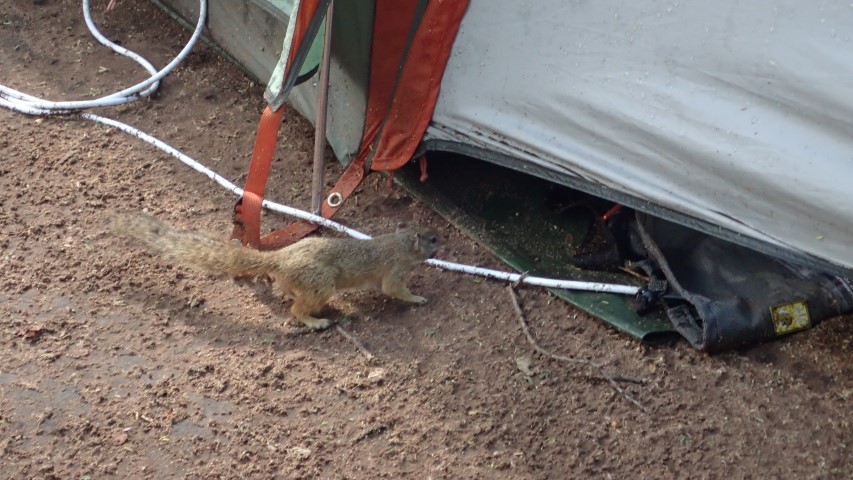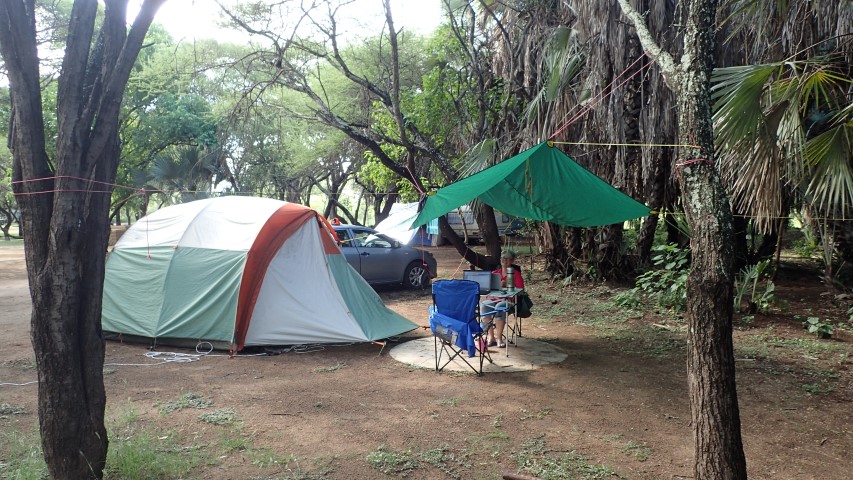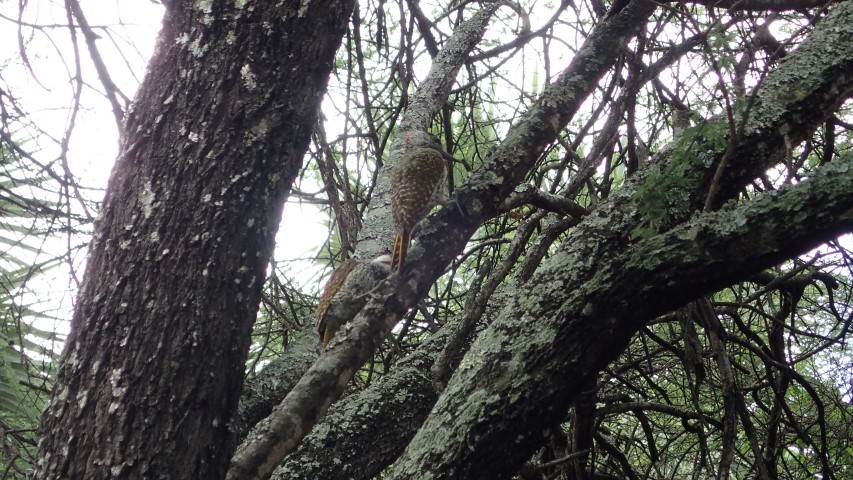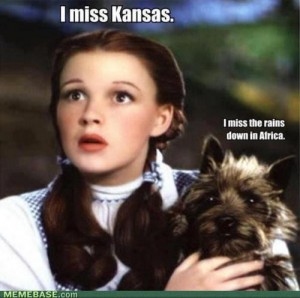
And one last piece of music, with beautiful photos
We’re at the O.R. Tambo Airport in Joburg, with an hour or so before we board the plane to Singapore. It’s a bit hard to believe we’ve been here for 6 weeks, and that our amazing African adventure is over. We’ve thrown stuff out, left other stuff in a pile at the campground hoping that some of it may find its way to someone else who can make use of it and packed up the stuff we’re taking home. We brought a set of portable digital scales with us to avoid the mad panic of chucking (even more!) stuff out at the airport as we did in the US last year. Our bags weigh about the same as they did when we arrived – we’ve added more books and a beautiful, but heavy, cast iron bread tin with a lid, and discarded some cooking stuff, linen and a few clothes.
We stayed at the Avant Garde Lodge in Kempton Park, near the airport in Joburg last night. We booked it on booking.com, but they also have their own website here. Lovely rooms, breakfast included and they also offer dinner. We were more than happy to eat there after driving 600kms, and there was a thunderstorm just after we arrived so it was good to not have to go out again to find dinner. It’s a great place to stay as it’s close to the airport, but it would also be lovely to spend a few days there lounging by the pool and enjoying the beautiful gardens.
The trip has been fantastic – much better than I dared to hope it would be. We didn’t get sick, mugged, robbed or scammed, weren’t involved in any road accidents, which was my biggest fear after we realised that South Africa really isn’t a dark, dangerous hotbed of crime – the drivers here really are terrible. Greg has handled all the driving with incredible grace and good humour – the awful road conditions, shocking drivers, occasional hard-to-find places – all of it has just become another part of the grand adventure rather than an insurmountable obstacle, thanks to Mr Adventure. He’s a great travelling companion.
Before we came, I hadn’t really thought too much about the wildlife we might see … or rather, I didn’t want to have high expectations in case we didn’t get to see much. Ha! It’s a bit like some of the other adventures we’ve had – all you have to do is turn up. We’ve seen so much wildilfe, but sadly never did see a leopard or a cheetah. We’ll put them on our wish list for next time. And there will definitely be a ‘next time’.Even though we have visited every South African province (some of them very briefly), there are still parts of it that we want to visit or revisit. Wouldn’t bother with the eastern coast again, but Cape Town, Western Cape and more of the North-Western Province, definitely. I’d go back to Kruger and Addo National Parks in a heartbeat, and would love to spend more time in Botswana. Namibia and Zambia will be on the list too.
To everyone who has been following along at home, thanks for reading, commenting, emailing and keeping in touch. We’re planning a 4WD trip at home in a few months, to do the Canning Stock Route in Western Australia. We won’t be blogging as regularly due to lack of internet access and power, but we’ll keep a blog and update it when we can. Hope you can join us for that one too!
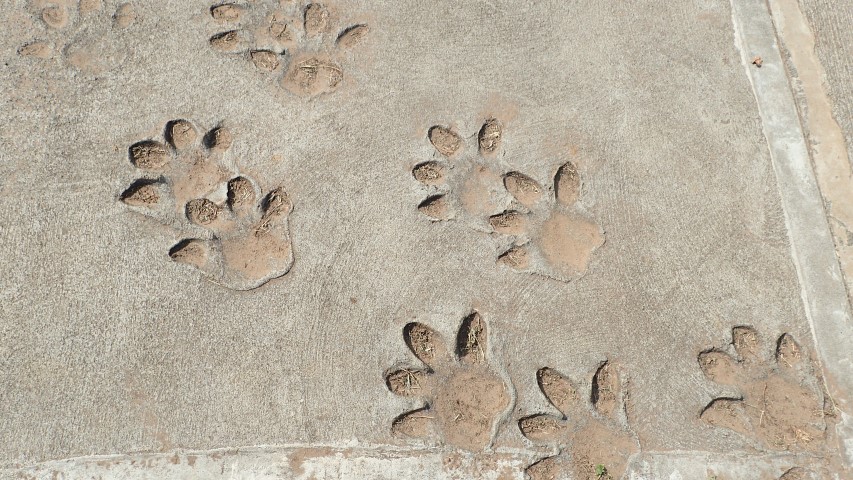
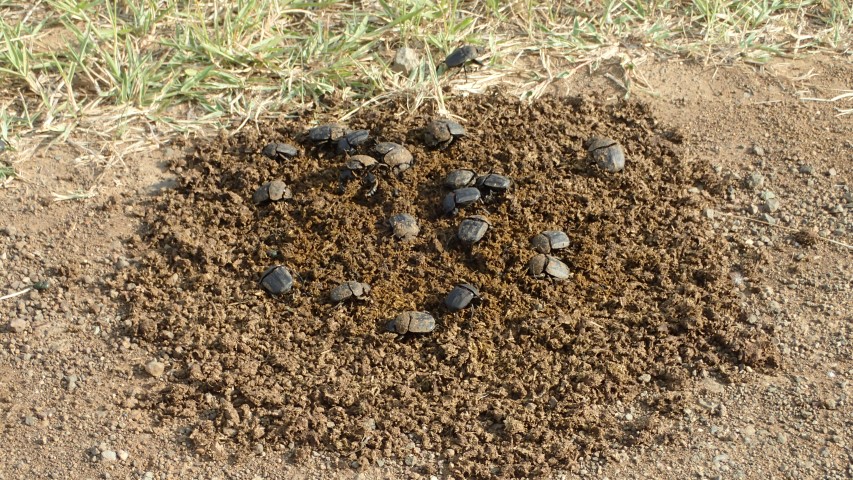
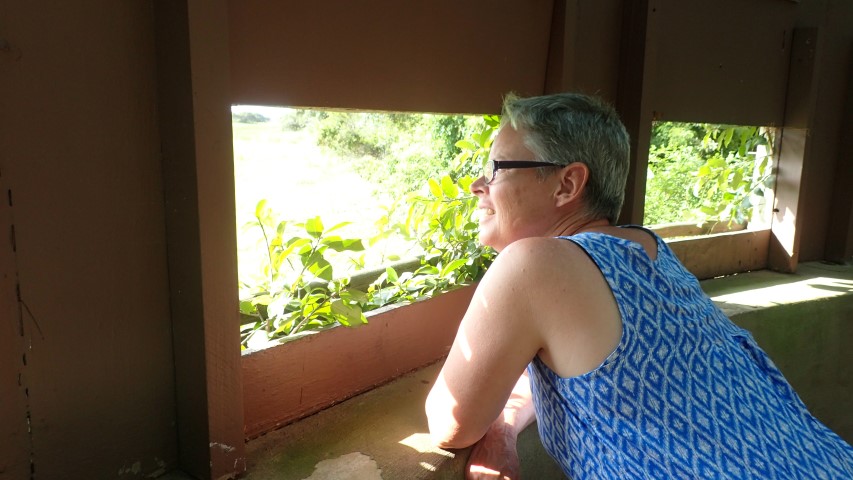
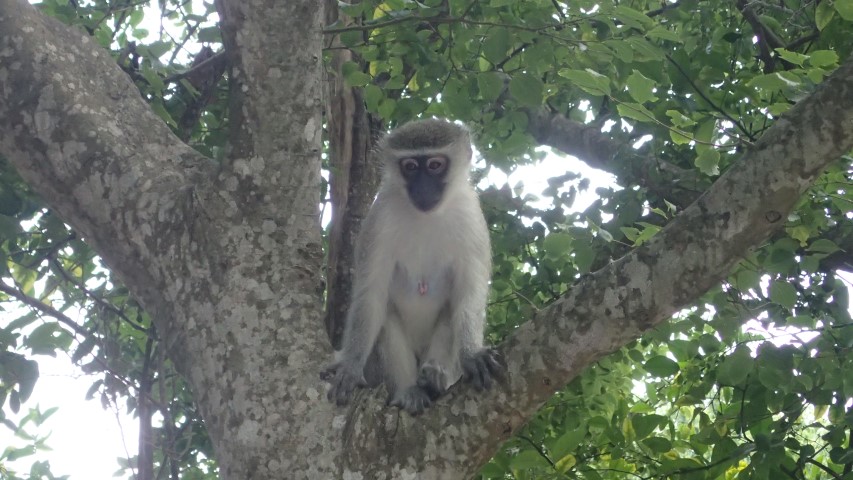
For our last couple of days and nights, we’re at a wildlife park on the north coast. Its one of the oldest and largest conservation areas in South Africa and goes as far north as the Mozambique border. The reserve is very long and narrow and includes several large freshwater lakes, plus Lake St Lucia which is actually a vast estuary for several rivers. It includes a marine sanctuary, a wide range of game animals, has breeding grounds for 2 marine turtle species, is one of South Africa’s top dive locations, and it seems that everyone apart from us is keen on fishing. As we drove to the campground we saw a zebra, a few antelopey thingys (couldn’t tell what type as they were too far away), and then there were a couple of new little antelopey thingys grazing near our tent site when we got here. Not sure what they were – some kind of grysbok or duiker, perhaps.
We’re staying at Cape Vidal campground, which is about 35kms north of the park entrance near St Lucia. This reserve isn’t part of the SA National Parks group, so our Wild Card doesn’t cover it and we paid an entrance fee in addition to the exhorbitant campground site fees. The entrance fee was okay, but at $55 per night for a powered site, this is the most we have ever paid to pitch a tent. It makes what we paid in Norway in 2013, and at Cradle Mountain, Tassie at Easter last year look reasonable!
The campground is fine, but nothing special – we paid less than 1/3 the night we pitched the tent on the deck in the forest and THAT was special. This one has sandy sites, unimaginative allocation system where we just got the next empty site in the row, when there are other more secluded sites that we’d prefer. Then the next people to come along got the site next to us, and so on.
The monkeys are here in abundance, but none have really bothered us yet. We sat and cooked in the tent last night, which was a good thing in more ways than one as we realised this morning that we’re back in a malarial zone. But just now I got up and walked 5 paces to put something in the car, and in that time a monkey came and sat on the laptop to check out if we had any food on the table worth stealing. They are swarming all over our next door neighbour’s tent and stuff, but he hasn’t left anything interesting out either.
So now we’re at the ‘what was I thinking’ stage of the trip. Happens every time – we end up with a strange collection of food that don’t go well together, and I don’t remember why I bought them in the first place. It’s not too bad though, we don’t have a lot left, apart from most of a kilo of ‘cake flour’. Every supermarket here sells 2 kinds of plain flour – cake flour and bread flour. Each has different protein levels, depending on what you want to use it for. I guess cake flour is the same as our plain flour.
Tomorrow is our last day, we fly out around midday on Saturday. We’ll pack up what we’re taking home, throw out and give away what we’re not, and drive the 600kms to Joburg. This afternoon we’ll drive around part of the reserve and hopefully see some wildlife
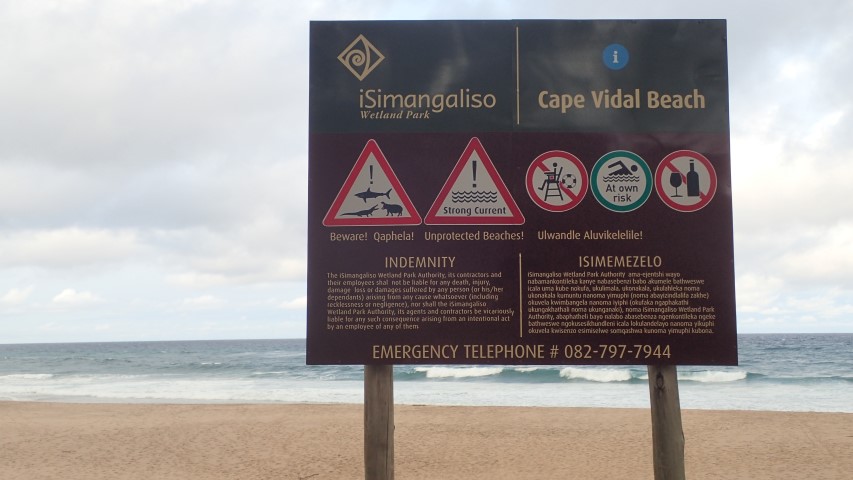

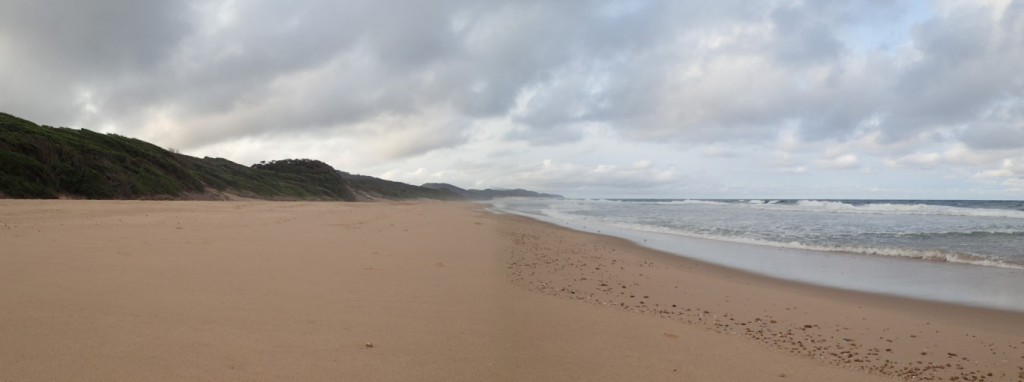
After a couple of days at Addo Elephant National Park, we’re on the move again, heading east towards Durban, where we’re planning on spending a couple of nights.
We went for a drive in the park yesterday afternoon and saw lots of wildlife, including a meercat. We hadn’t seen any meercats before. And just as we’d decided we’d seen enough and were heading back to camp, we found the most beautiful young mother elephant and her calf, eating grass close to the road. We spent ages just watching the 2 of them eat, pulling up a few blades of grass at a time with their trunks. Their trunks are incredible instruments – capable of such fine actions, but also of smelling and detecting things. Their eyesight is very poor.
Close to the park’s office complex is a viewing deck overlooking a waterhole where elephants go to drink. It’s floodlit at night, which doesn’t seem to bother the elephants at all. We walked to it after dinner last night and there was one big fella having a drink.
We drove through Adelaide in Eastern Cape today. As far as we know, apart from our hometown, it’s the only other Adelaide in the world, so we just had to go there. Lots of ‘Welcome to Adelaide’ signs, it has a hospital, a large town square and a museum in an old stately home from the 1860s that looks like it should be on a tobcco plantation in Louisiana, USA. Unfortunately the museum was closed. Not sure what the population is, a couple of thousand perhaps. Like its South Australian namesake, there seemed to be a lot of churches!
We’re staying at a campground just east of East London and we’re the only campers here, although Greg went to try and have a look at the beach (no luck, there’s an electric fence in the way) and one cabin is also occupied. Bit of a shame as the campground has a lovely pool and other facilities, but the road here from the freeway is appalling – major road works on the access road, then a rutted unsealed track that most caravan owners probably wouldn’t like to drive on. Just up the road a bit is a nice sealed section, with brick walls and footpaths on both sides of the road. Strange thing is that behind the brick walls is just an overgrown mess. Like a developer got as far as a decent road and a bit of infrastructure, then ran out of money.
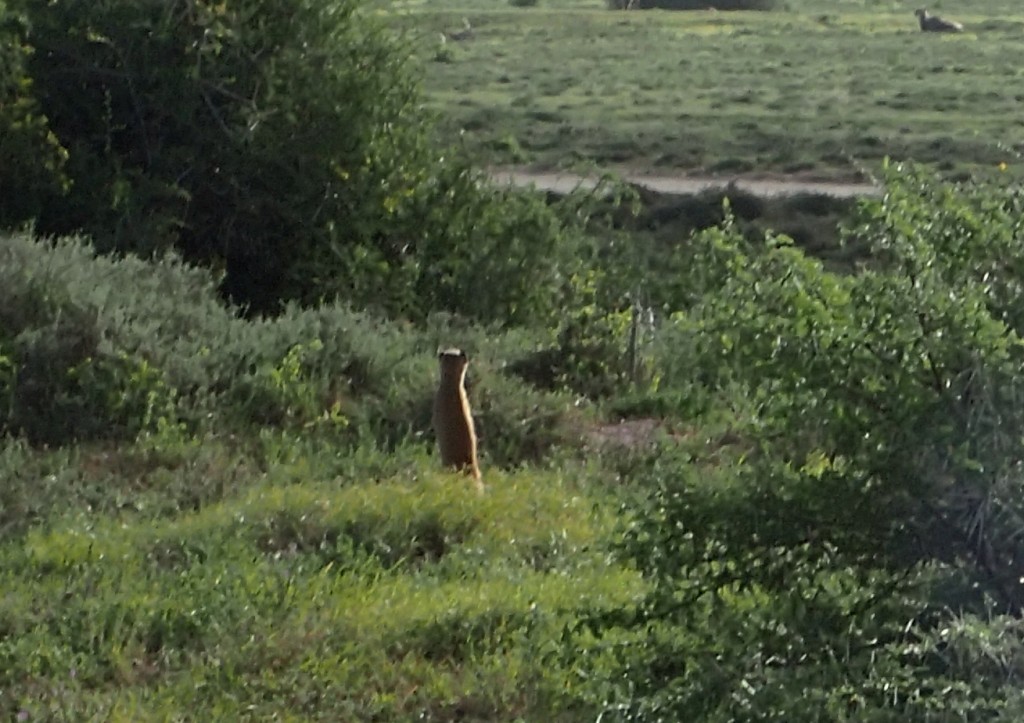
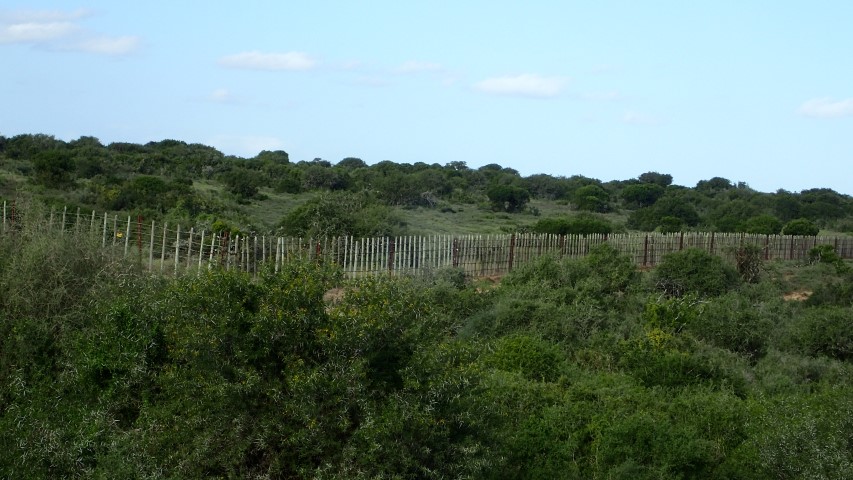
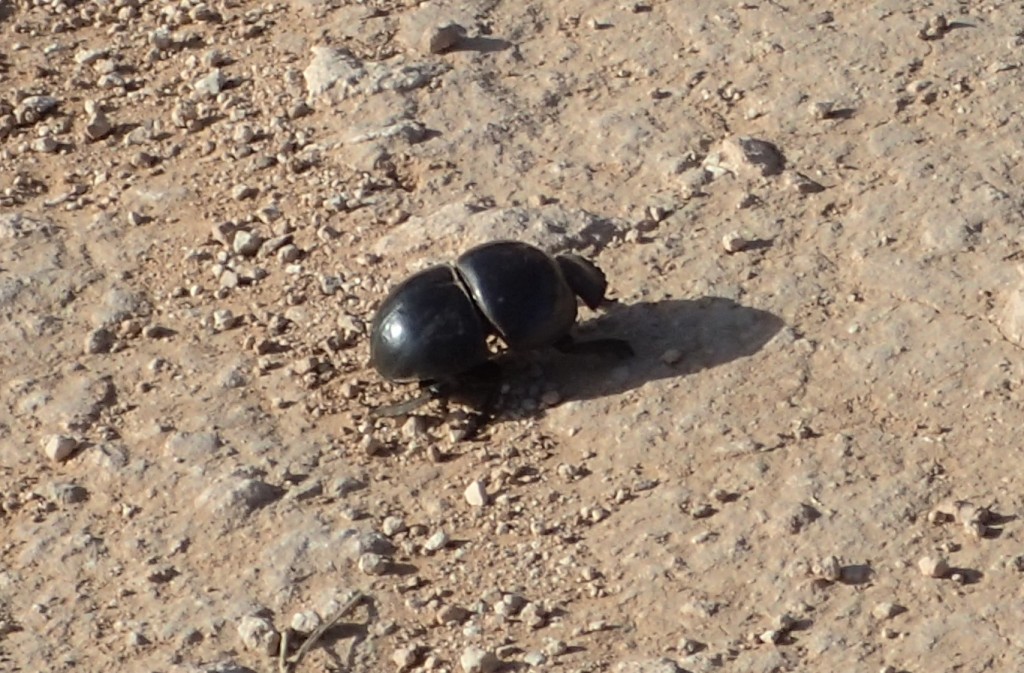
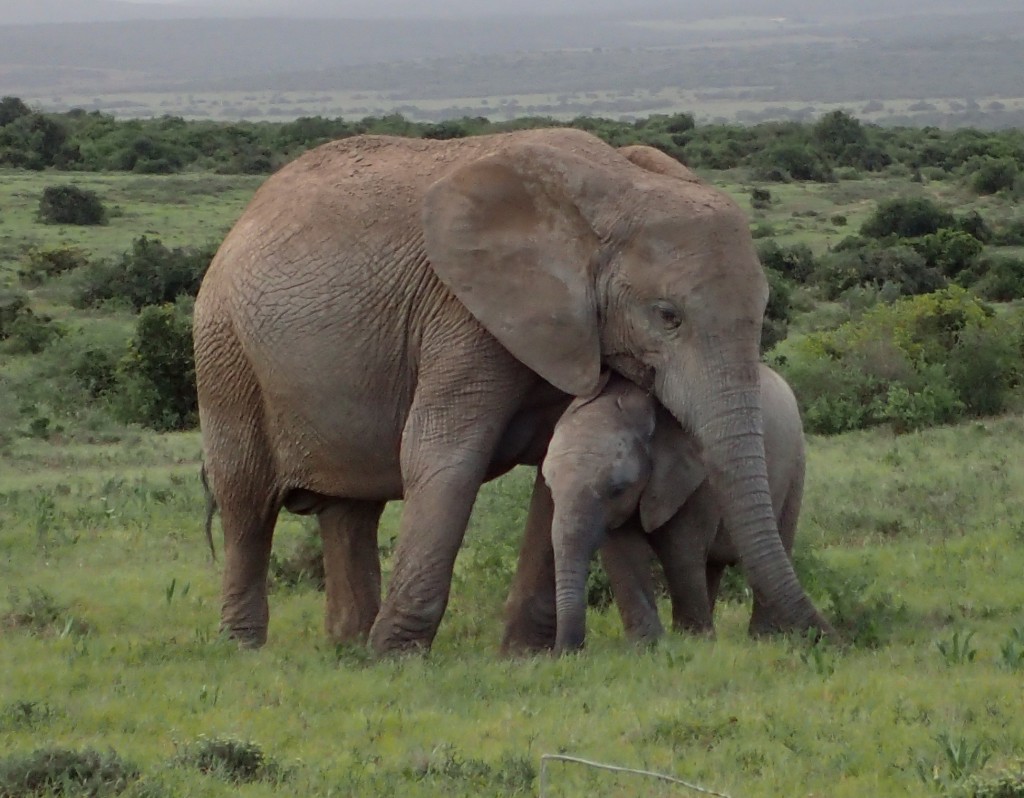
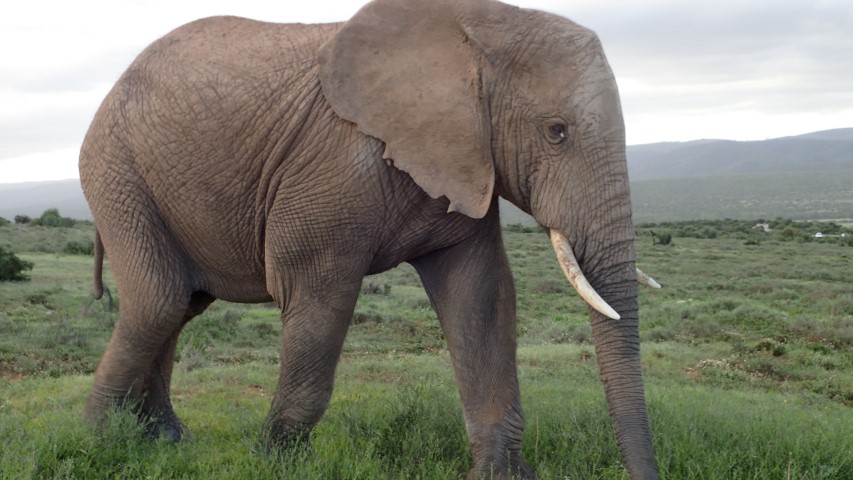
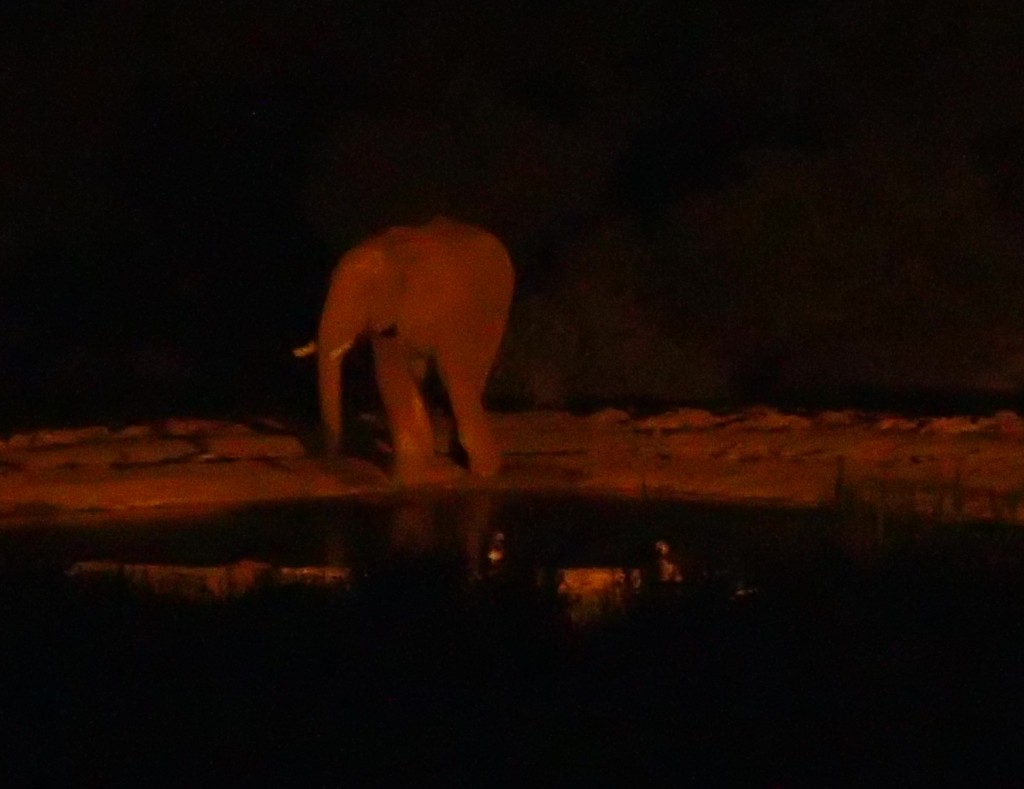
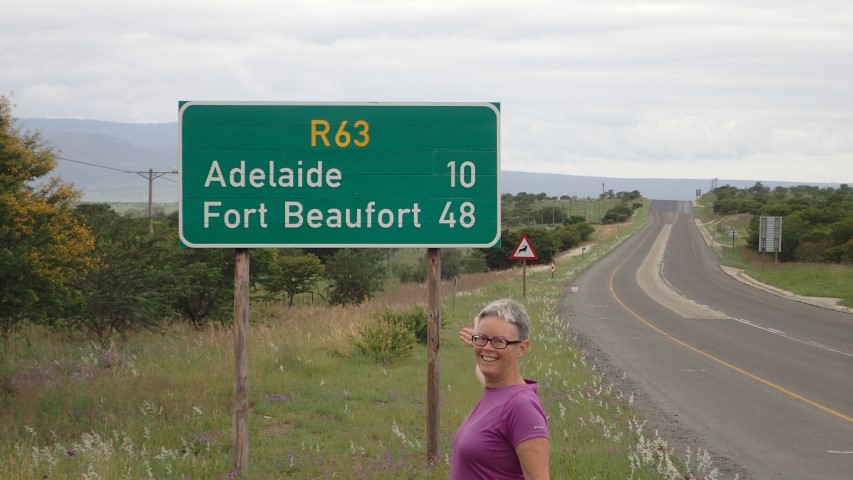
We’re heading east to Durban, and then eventually back to Jo’burg. We drove through Western Cape yesterday, and now we’re almost in Eastern Cape, spent last night camping at the Glentana Beach campground, which is set just back from the beach. There are 2-storey beach houses along the beachfront, then the campground is set just behind the houses in a secluded area, and then there are more houses behind the campground on higher ground so they have a view. So having the campground in the ‘hollow’ seems like good use of the space.
Eastern Cape is in the ‘Garden Route’ part of South Africa. Not sure if it’s just clever advertising, but the climate here is apparently one of the most temperate in the world. Mild winters, comfortable summers and plenty of rain, if the grassy campsites are anything to go by. There is a team of guys here lawmmowing and whipper-snipping the thick grass, and where they have already been looks like a bowling green.
We drove past the turn-off to Cape Agulhas, the southern-most tip of South Africa yesterday morning. It is also the official dividing point of the Atlantic and Indian Oceans. We didn’t go there – maybe next time!
Not a lot of wildlife-spotting recently, although I did see a dwarf mongoose at Table Mountain, and we saw some rock hyraxes at the Cape of Good Hope. These mammals look like giant brown guinea pigs, ranging from 2 to 4 times the size. What’s really interesting and quite amazing about them is that their closest living relatives are the elephant and sirenians ( which includes the dugong and manatees)!
We’ve booked a couple of nights at the Addo Elephant National Park, which is a couple of hundred kms further east. We couldn’t get in tonight, so we’ll try the Garden Route National Park which has incorporated several national parks and forests, with a few accommodation options.
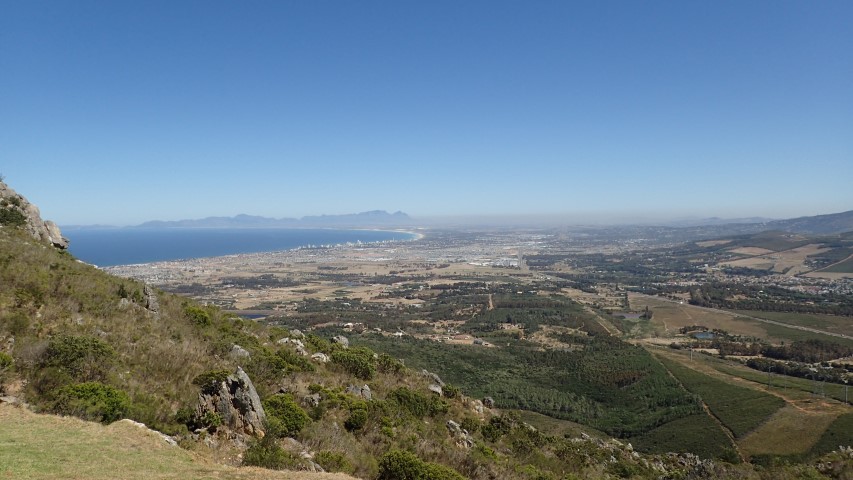

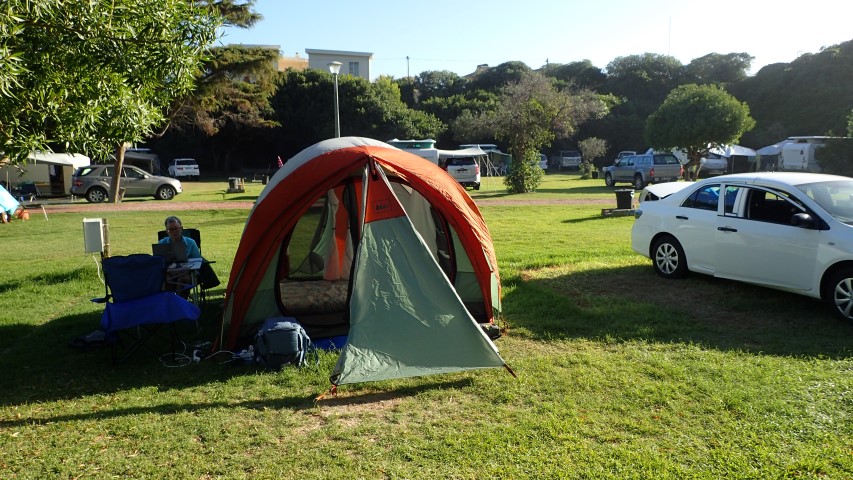

Wildlife tally for Friday & Saturday Feb 6 & 7
antelopey thingies – impala, springbok, nyala and a new one that we hadn’t seen before
buffalo
hippo
zebras
crocodile
warthogs
New to the list – a bontebok that was beside the path as we drove out of Malolotja Nature Reserve yesterday morning.
The day started off cool and misty, but once the mist had lifted, it warmed up. We had planned to have a drive around a couple of the places of interest in the nature reserve, but the first track we took was so bad, we gave up and left the reserve. The previous afternoon the receptionist had marked a map to show us the ‘roads’ we could take, and the 4WD-only tracks, but they all seemed more like 4WD tracks!
I’m feeling even more relieved that we spent the night in the log cabin rather than the tent – a Swazi newspaper headline this morning reported that ‘2 students were struck by lightning, 1 died’ after the Thursday afternoon and evening thunderstorms.
We drove to Mbabane, the capital to find some internet access and lunch. We tried an internet cafe, paid for 30 minutes each, but it was so slow we gave up after 15 minutes, having achieved absolutely nothing for the $5 we spent. The steakhouse chain we had lunch at offered free wifi, so we were able to get a few things done while we had lunch.
Then on to Manzini, the largest city in Swaziland, just for a look. We wandered around the local market, but by this stage our nerves were so frazzled by the appalling driving that we really just wanted to get off the road and stop for the day.
We got an unpowered tent site at the Mlilwane Wildlife Santuary – all the powered sites were reserved by a large contingent of campervans, the most we’ve seen in Southern Africa. We could have stayed in ‘beehive hut’, a round, domed structure made of woven grass arranged in 3 circular ‘villages’, but we were both happy to get back to our tent. We were visited by the local wildife – zebras, warthogs, impala – and a couple of other families arrived later and set up their tents.
Today we have driven back to Jo’burg, where we’ll spend the next 4 days staying in a loft apartment in Maboneng, a newly trendy part of town. Formerly an industrial area, the developers have bought up a lot of factories and warehouses and turned them into housing, restaurants, arts spaces and shops. The apartment we’re staying in belongs to a young man who works for the developer. You can see photos of it and the surrounding area here.
It’s all happening down on the street, 2 floors below us, and we’re heading out to find some dinner. The Maboneng Precinct website lists over 20 local restaurants & cafes offering a variety of cuisines, so I’m sure we’ll find something interesting down there.
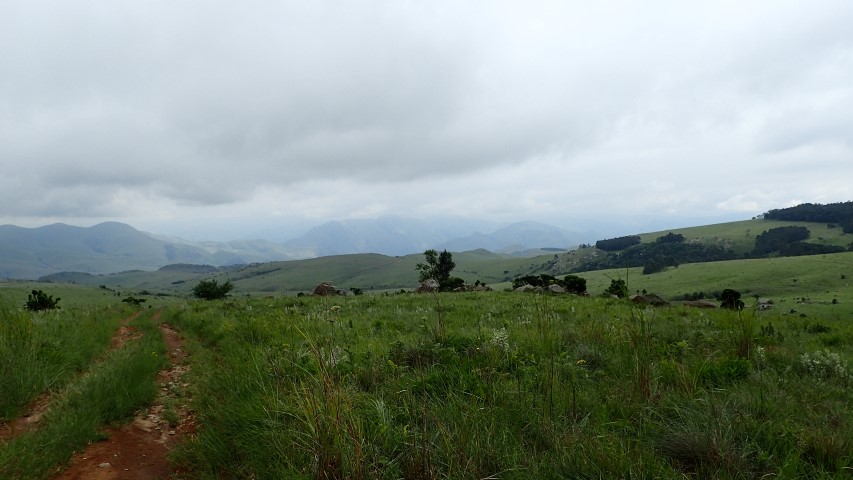

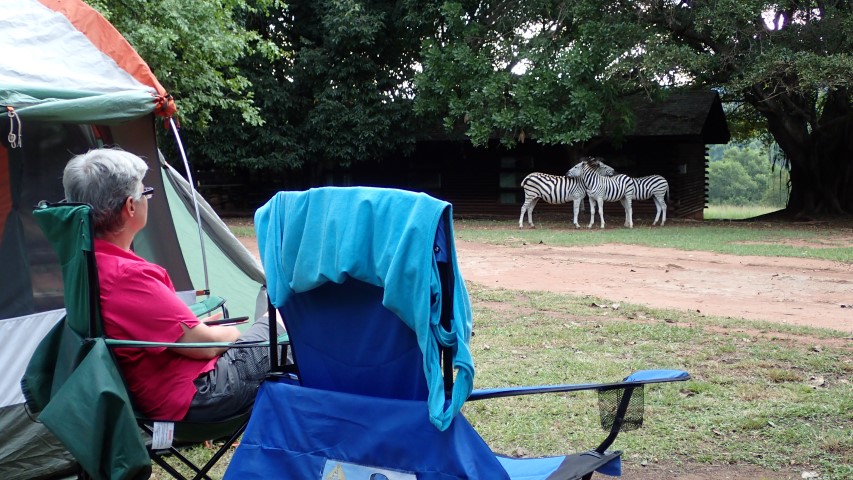
Wildlife tally for Wednesday Feb 4
elephants
giraffes
antelopey thingies – impala
buffalo
hippo
warthogs
zebras
white rhinos
blue wildebeest
tortoise
storks
vultures
New to our list today – a rock monitor who lives around our campsite. A very good reason to take a torch and wear thongs or sandals when venturing away from the tent in the dark.
We took a short drive out to Mlondozi, a popular picnic spot a bit north of Lower Sabie. Up on a hill, it overlooks a river and the Lebombo Mountains, which mark the border with Mozambique. So that’s probably as close as we’ll get to Moz. The picnic area was busy, and I guess in the busy periods it would be impossible to get into … or out of. Not much wildlife around at that time of the day, and it was hot – 37C
We headed back to camp for a swim, then went for a drive later in the afternoon, south towards Crcodile Bridge. We saw 4 more rhinos, including a group of 3. Plus a big group … oops, tower … of giraffes. 8, the most we have seen together. And on the flora side of things, we found sausage trees! Lovely large leafy trees that have red flowers in spring, which become sausage-shaped seed pods that drop in autumn. They are heavy so it’s best not to stand under one of these trees at that time of the year. The only animal that likes to eat the ‘sausages’ is the baboon. The seed pods are very fibrous.
Last night’s dinner was blue wildebeest schnitzel steaks, cooked on a braai! The wildebeest smelt a bit ‘gamey’ when it was cooking, but they tasted very much like beef. 500g cost less than $6, and as Greg pointed out, they were probably as low in food miles and carbon footprint as we could get.
We had a HUGE thunderstorm last night. Clear sky when we went to bed, 2 hours later the lightning and thunder woke us up and we took shelter in the car for a while. This morning … clear sky again, and very high humidity.
We’re leaving Kruger today. Its been an amazing week here, but now it’s time to move on and find more adventures. We’re going to Swaziland for a couple of days and may not have internet access there. In which case, see you on Saturday when we get to Joburg
Everything Greg knows about lions, he learnt from The Lion King movie
A group of lions is called a ‘pride’, but only if they are standing on Pride Rock. We haven’t found Pride Rock yet, so that might be why we haven’t seen many lions.
He keeps looking for meerkats, but hasn’t found any yet. But they must be here somewhere ‘cos we’ve seen heaps of warthogs, and Timon and Pumbaa were best buddies.
Warthogs are much, much uglier in real life than Pumbaa was in the movie. They must have Photoshopped him.
Zazu the bossy bird in the movie (Rowan Atkinson was his voice) was a red-billed hornbill, like the one that fell in love with our car when we camped at Satara Rest Camp. We didn’t realise it at the time or we would have made sure we got a photo. We have seen a few since, but never close enough to get a decent photo.

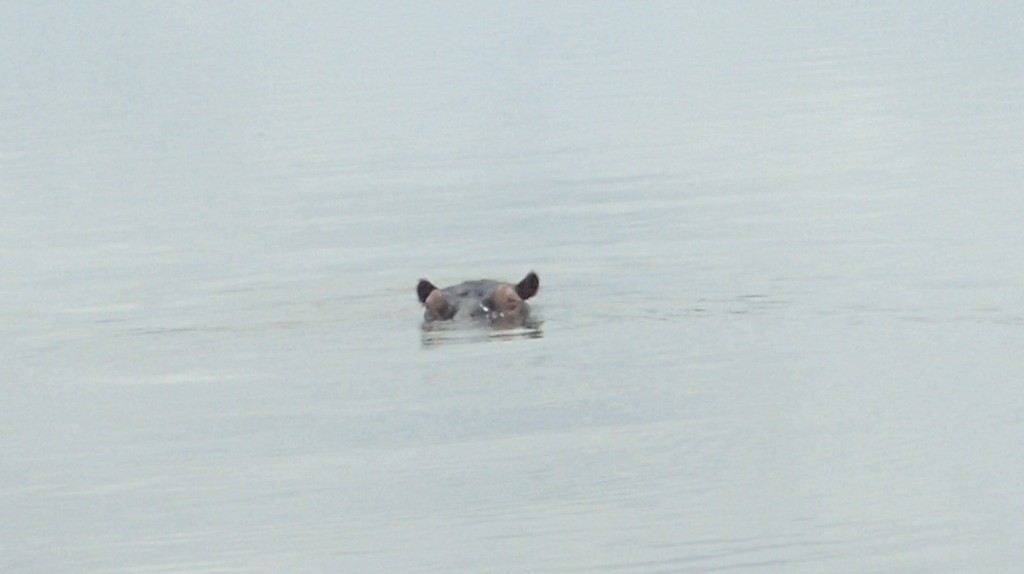
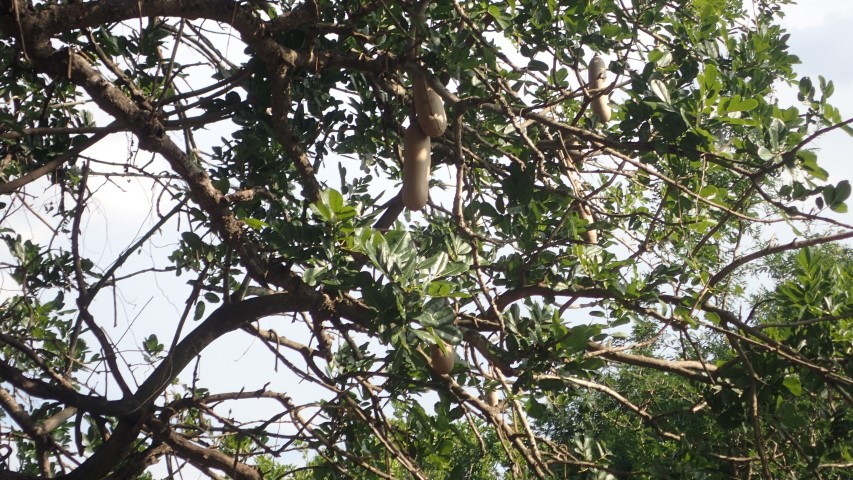
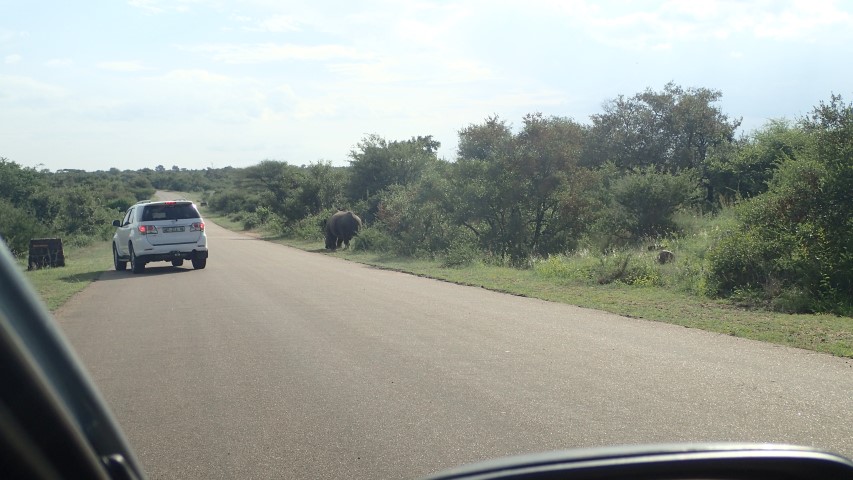

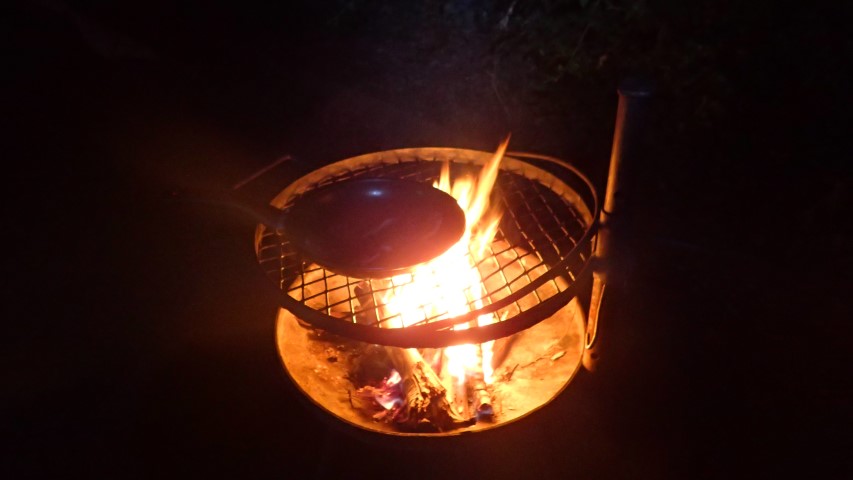
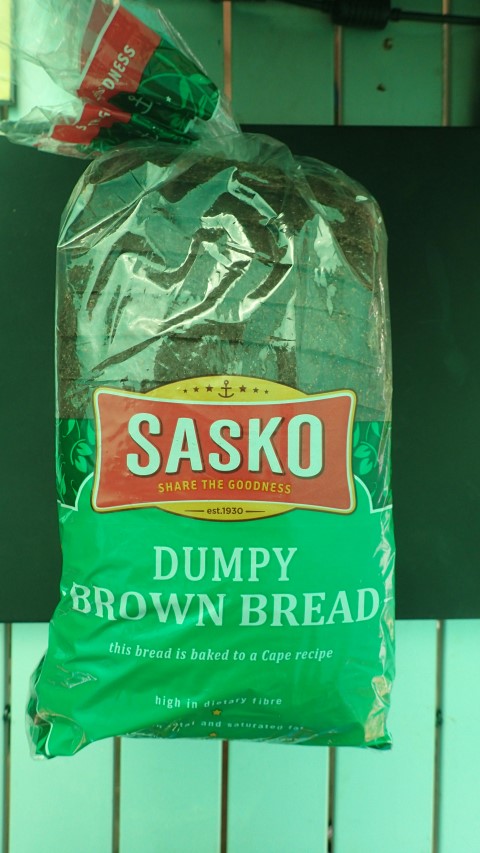
Wildlife tally for Tuesday Feb 3
elephants
giraffes
antelopey thingies – impala and waterbuck, plus a couple of new additions to the list below
blue wildebeest
buffalo
mongoose
baboons
New to our list today
guinea fowl
duiker – a little antelope with very delicate features and tiny horns
springbok – we realise that we’ve probably seen lots of these before and thought they were impala. Springbok have straight antlers that curve at the end. Impala have antlers that twist. In case you were wondering.
vultures – we think a group of vultures should be called a ‘death-watch’. According to wikipedia, it’s a wake, committee, venue, kettle, or volt. ‘Wake’ is pretty good, but I still like our ‘death-watch’ the best.
African wild dogs. We saw a pair of them at a waterhole and got pretty excited. They are rare here, according to wikipedia, in 2009 there were only about 150 in the whole of Kruger.
Number 1 spot must go to the pair of rhinos we saw on our way to Lower Sabie campground yesterday afternoon. I hadn’t really thought we’d be lucky enough to see any here, but this mother and son pair just wandered onto the road we were driving along. They stood there for a couple of minutes while we got all excited and took photos and a video, then they wandered off into the scrub. If we had been just a couple of minutes later, we would never have known they had been there. Rhinos are HUGE! Much larger than I thought they would be.
We’re now in the southern part of Kruger, staying at Lower Sabie campground. Lots more people in this part of the park – campers, tourists, tour buses, sightseers. We drove from the park’s main campground & administration centre Skukuza yesterday afternoon and that was when we saw most of the animals on the list above. We’ve decided that late afternoon drives are the most worthwhile as that’s when the wildlife is out and about. On that same stretch of road, we saw some elephant dung on the road, with lots of whole, unripe marula in it, and a bit further down the road we found the elephant! Wandering all over the road, picking at bits of shrub then dropping then, a bit unsure of where he was going next. We just sat and waited until it was safe to pass him. In the comments section of the Satara Rest Camp post, our friend Hazel warned us about marula-eating elephants, and we’ve seen a youtube video of an elephant destroying a car in Kruger, and didn’t want a repeat of that.
Dinner last night was springbok burgers that we bought from the well-stocked shop at Skukuza. 4 burger patties cost us less than $5. We could also have had warthog fillet, various antelopey-thingie sausages and a variety of other game meat choices, in addition to beef, chicken, lamb and pork. Tonight we’re thinking of cooking some kind of boerwors (long sausage that’s curled into a circle) on a braai, as long as we can get some firewood. We’ll share photos, of course.
The rental car company, Avis, has given us permission to take the car into Swaziland, so we’re heading there tomorrow for a couple of days. We have used Avis for our last few trips and they have alway been very helpful, and even replaced the car when we (and they) couldn’t get a tyre to replace the one that got wrecked while we were driving in Oslo.
I know almost nothing about Swaziland, apart from what I read in Richard E Grant’s book The Wah Wah Diaries, about making his autobiographical movie, Wah Wah. There are a couple of national parks and we’ll camp somewhere. The capital, Mbabane, has a population of 60,000, Swaziland is a landlocked country, sharing borders with Mozambique and South Africa. They have their own currency, but the South African rand is accepted there, which we’re happy about as we won’t have to exchange any money. I went into a bank yesterday clutching a wad of Botswana pula, hoping to exchange them into rand. The teller almost shooed me out, so we’re going to try at Joburg airport. I now know that the rand is accepted in Namibia, Botswana, Lesotho, Swaziland and of course South Africa. Various travel sites also claim that it’s accepted in Zimbabwe, which may be true outside of Victoria Falls, but at Vic Falls it’s USD all the way. Which seems odd when the US has trade sanctions against Zim.
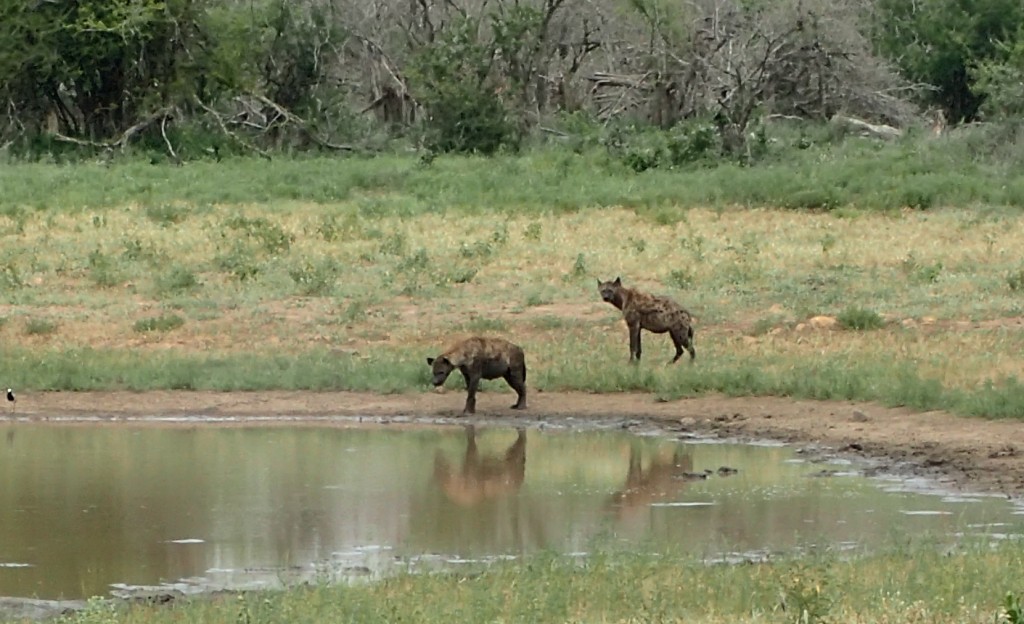

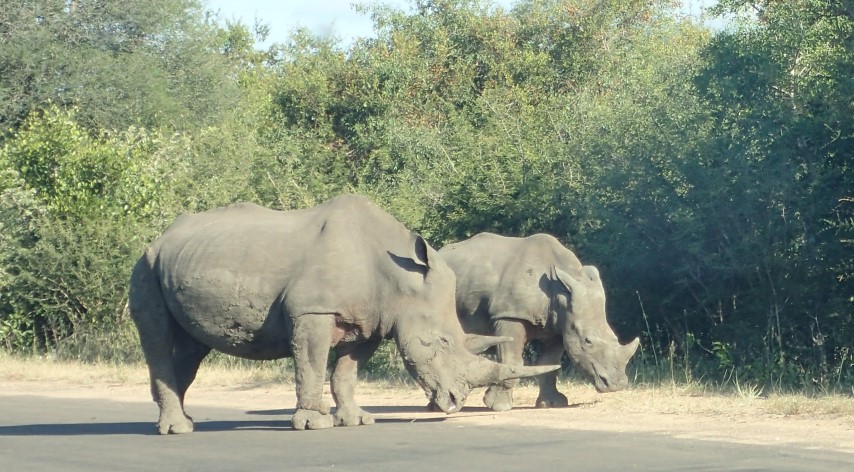
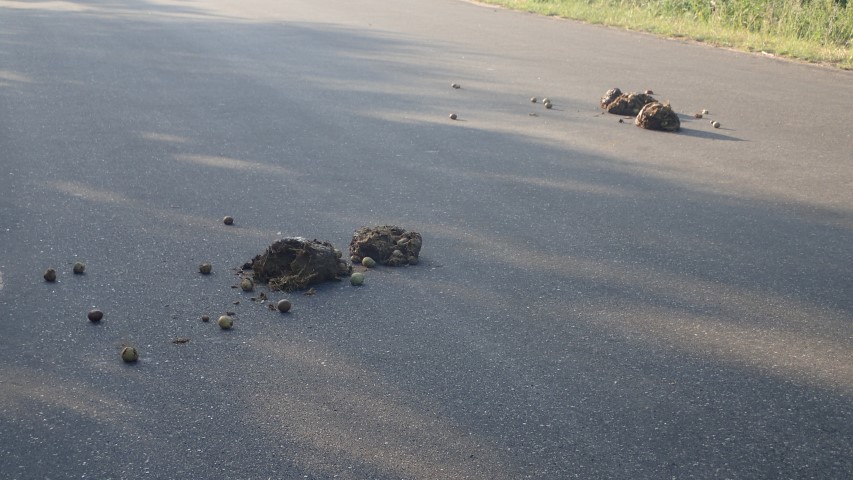
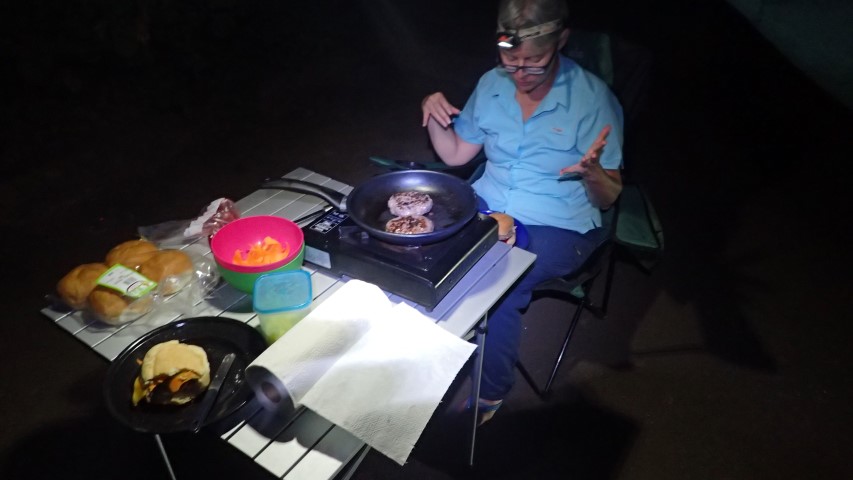
Wildlife tally for Monday Feb 2
zebras
elephants
giraffes
antelopey thingies – impala and waterbuck. We see so many of them that now we just call them all ‘antelopey thingies’. If we find something different that we haven’t seen before, I’ll add it to the list
blue wildebeest
baboons
New to our list today – lions! 2 lionesses actually. They were about 100 metres away from us, sitting in grass near a bush and we could really only see them when they raised their heads. If someone hadn’t stopped to tell us they were there, we wouldn’t have known. Still, it was exciting for us to finally see them. Greg marked the spot on the GPS and we stopped again on the way back – they had moved into the sun as it was late afternoon and ther previous spot in the shade would have been getting cool. Then last night there was one roaring and growling somewhere nearby … on the other side of the campground fence, I hope!
Despite the title of this blog post, we’re not going to Mozambique. We thought about it as Kruger National Park continues across the border into Mozambique to become the Limpopo Transfrontier Park, and visiting the capital, Mabuto, would be interesting. But we can’t take the car, a day visa costs $80 each and we heard a horror story about corrupt Moz immigration officials from a South African woman when we did the tour to Vic Falls. I’ll re-tell it here in the hope that it warns other people to be vigilant at borders.
This woman had been to Moz at least half a dozen times before and travels around Southern Africa a lot, so she isn’t a novice, but the last time she and her adult daughter went to Moz, their passports weren’t stamped and they didn’t realise it. She remembers hearing the thump of the stamp, but it didn’t go on the passport. They only realised when they were trying to leave the country and got hit with a 2,500 rand fine each (around $300). They didn’t have that kind of cash with them, so the officials held the daughter while the woman went try and get the money from an ATM across the border. While she was there, her car was robbed and she lost phones and other valuables. The daughter eventually got away and the woman got in touch with Moz officials much higher up the chain and got it sorted out. But tourists wouldn’t have the time or connections to be able to do that.
So …. anyone travelling to Mozambique needs to be vigilant about making sure their passports are stamped properly.
We’re heading south today, but still staying in Kruger. We’re planning on camping at the Crocodile Bridge campground as it’s good for seeing lions and rhinos. Fingers crossed! On the way, we’re calling in to Szkuza, which is the main camping and admin area in Kruger. There is an Avis office there and we want to get written permission to take the car into Swaziland. If we get permission, we’ll spend a couple of days there before we head back to Joburg on Saturday.

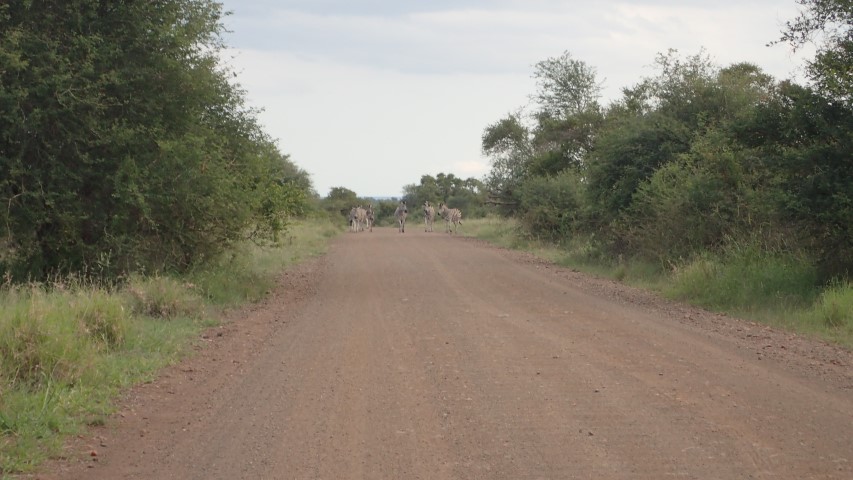
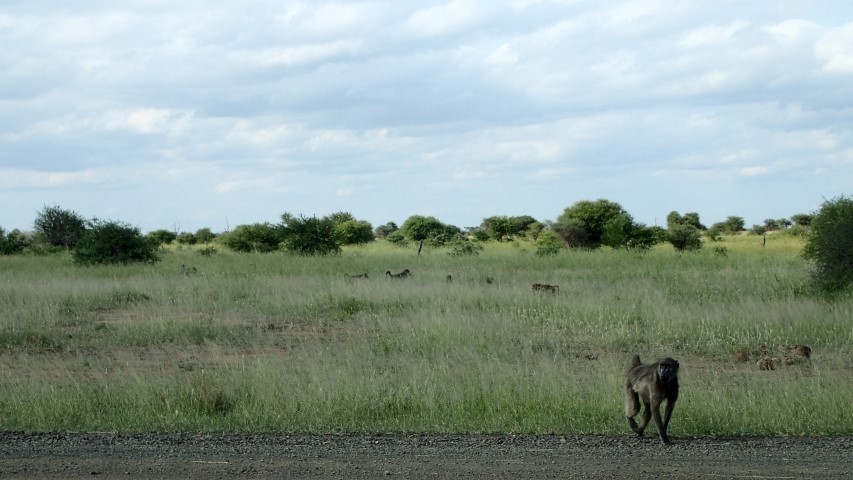
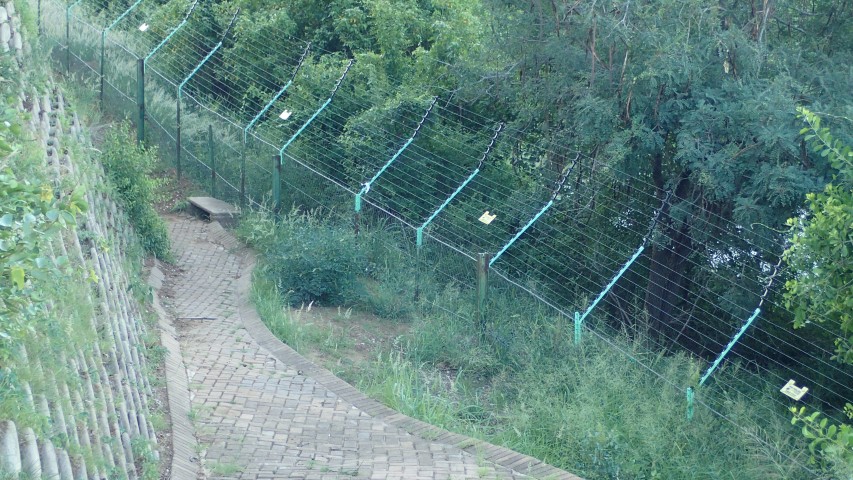
Wildlife tally for Sunday Feb 1
We’ve learnt some new words for describing groups of animals, and couldn’t wait to show off our improved vocabulary. There’s a good list here
Here’s what we saw yesterday.
dazzles of zebras
a couple of herds or parades of elephants
a bloat of hippopotamus
a tower of giraffes
impala
bushbuck
waterbuck
common reedbuck
a leopard tortoise
New to our list today – lots of banded mongoose including many babies and an implausibility of blue wildebeest.
My favourite group description is a ‘dazzle of zebras’, Greg’s is ‘an implausibility of wildebeest’. I’m really hoping to see a crash of rhinos while we’re here. Greg has added more photos to our last post, Out & about in Northern Kruger National Park, including a better pic of the crocs with the dead hippo, so you can play ‘Spot the Crocs’.
We have been befriended by a Southern red-billed hornbill. He has fallen in love with our car, or rather, his reflection of himself in the car’s windscreen. He’s quite tame, very persistent, quite vocal and I reckon if Greg spent enough time with him, he’d be able to teach him how to count to 10 by the time we leave.
Our friend Margaret commented that she hadn’t realised that Kruger National Park was so popular. Here’s a bit more info about it:
Around 19,500 square kms, covering 350km north-south and 60km east-west. The entire eastern boundary forms the border with Mozambique, and with Zimbabwe along the Limpopo River to the north. Along the western edge are several large privately owned game reserves, most (if not all) of which offer upmarket accommodation and wildlife experiences. We’re not upmarket enough with our tent, so we’ll stick to staying in some of the 26 (!!!) campgrounds in Kruger, which are able to provide accommodation for over 4000 people per night. We moved to the Satara Rest Camp this afternoon, which is in the Central part of Kruger. There are 3 guesthouses here, 180 self-contained units and a 600-site campground. And there are a couple of even larger campgrounds further south!
It hasn’t been busy anywhere we’ve stayed or driven, but during the summer and other school holidays, I’m sure it would be packed. It’s only a few hundred kms from Joburg and Pretoria and South Africans do love the outdoors. I think they are even keener barbecuers than Australians, if that’s possible. They call a barbecue a ‘braai’ – rhymes with ‘dry’ – and have all sorts of braai utensils and equipment that we’ve never seen before. We bought a beautiful cast-iron bread tin with lid (like this one here) that I’m looking forward to using when we go outback camping at home. A braai is standard in all campsites – it might be a half 44-gallon drum on its side, some kind of large dish to hold coals with a grill above it or even just a concrete area to light a fire on. There is always something so that people can cook outside … and they do!
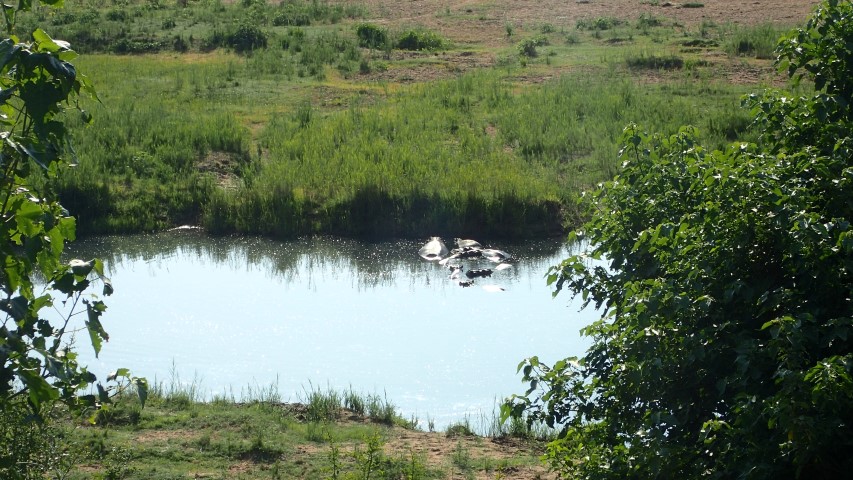
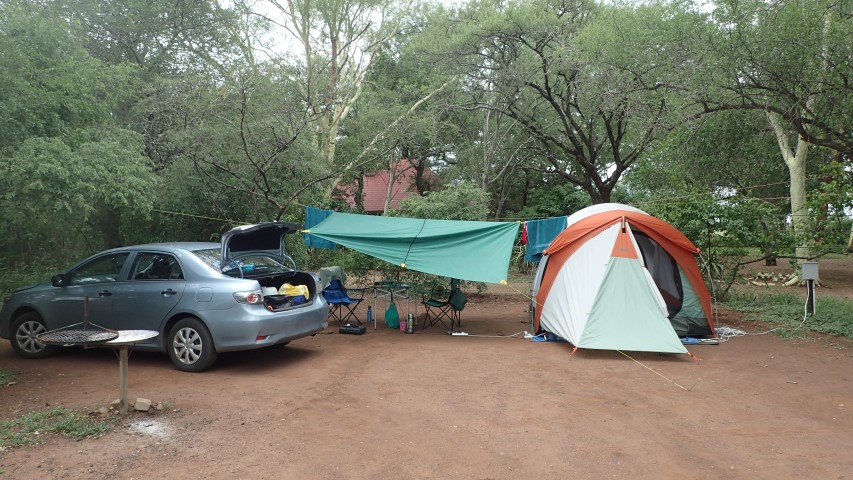
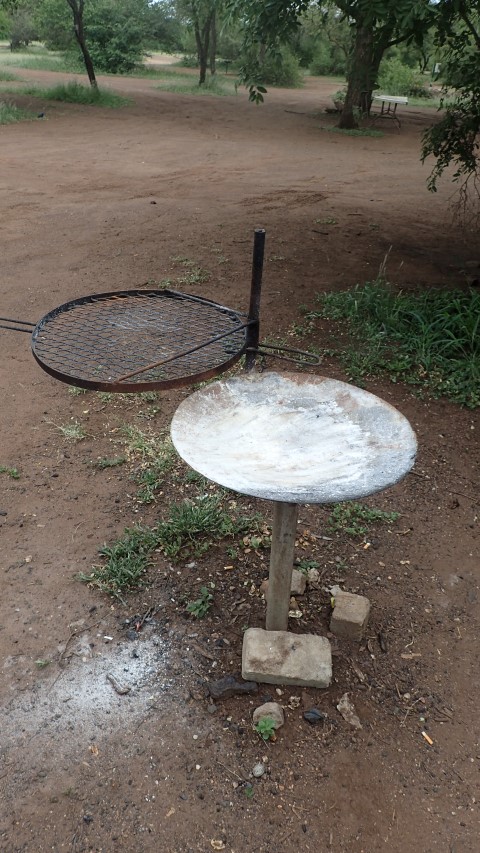
We’ve spent the last couple of nights at the Letaba Campground complex, and done a couple of drives around this northern part of Kruger – one during the day yesterday to Olifants Camp , and an early morning drive to Englehard Dam this morning. We’re not usually ‘morning people’, but the combination of birdsong and cars driving past to do their own early morning drives had us up and out the entrance gate of Letaba by 5.50am.
Yesterday’s drive during the heat of the day took us along the Letaba River. We saw a group of zebras just across the track we were driving on, a couple of groups of buffalo (we’re a bit scared of them as apparently they charge without warning and are the most aggressive of the ‘Big 5′ animals), and lots of antelopes. There are many different antelope species, I’ve managed to identify 3 or 4 so far, thanks to our guide book which lists 20 or so. Nyala, impala, bushbuck and this morning we saw some waterbuck.
But the most interesting thing we saw yesterday was at Oliphant River, which has among the highest densities of crocodile in Africa. It took us a few minutes to work out what we were seeing in the water … a dead hippo with about a dozen crocs around it. We counted 8 or 9 at the time, then looked at enlarged images of the photos Greg took when we got back to camp and realised there were more than that, including one lying on a nearby rock that we hadn’t even noticed at the time, we were so busy looking at the crocs around the hippo. Poor hippo had been there for a while, if the smell was anything to go by. No carrion birds – maybe they get their turn after the crocs have finished.
Just after we set out this morning, we saw some fresh piles of elephant dung on the road, but only saw one elephant a few kms further along. He just walked about 5 metres in front of the car, straight across the track towards the river. He was a man with a mission, took absolutely no notice of us, although if we had been any closer, it could have been awkward. The track led to a great view of Englehard Dam, and on the way back we saw hippos lolling in the water, waterbuck and birds.

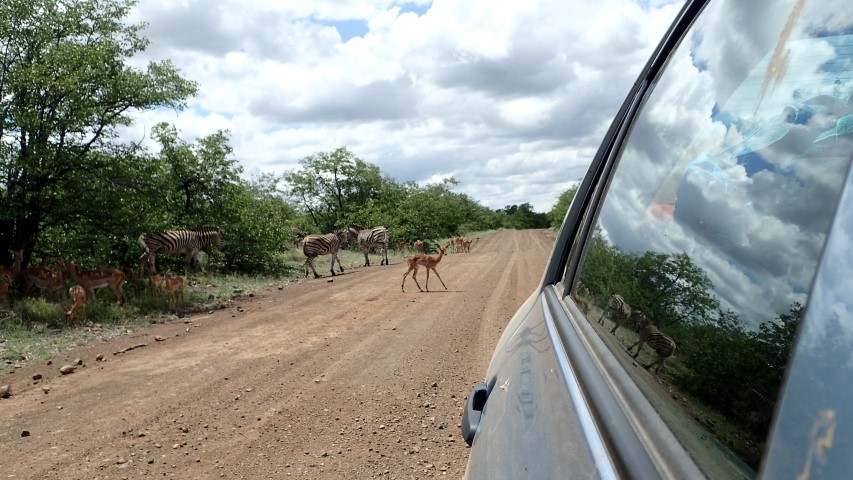
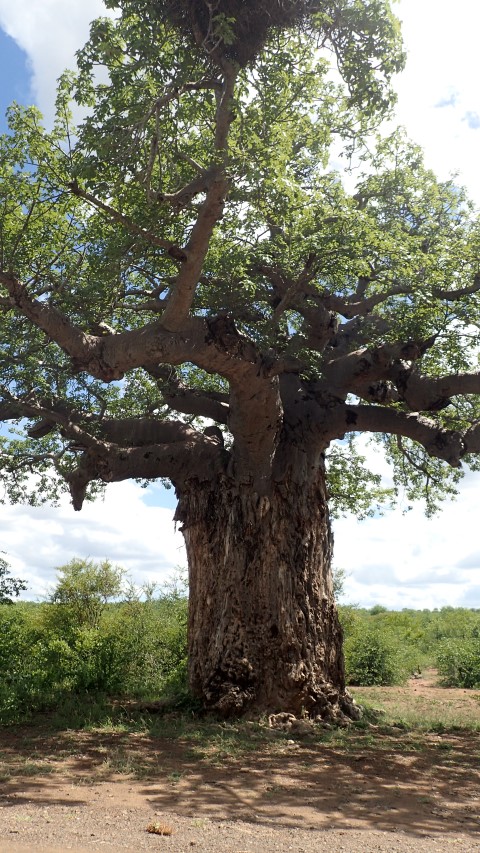
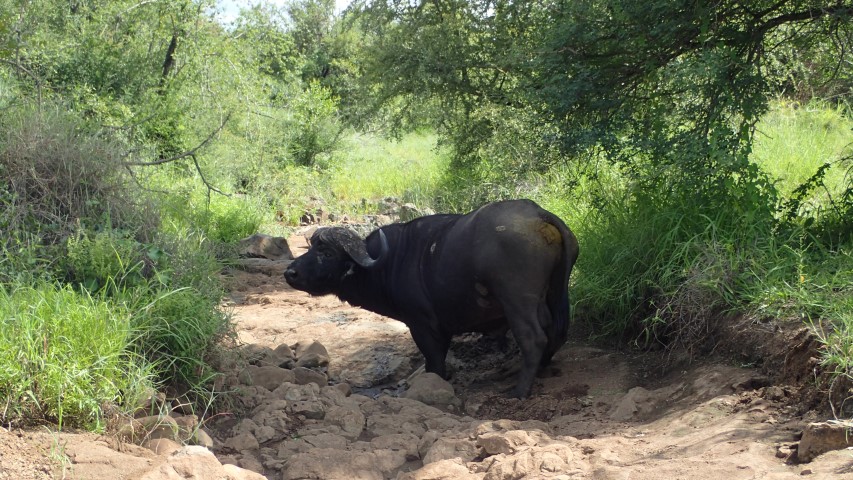
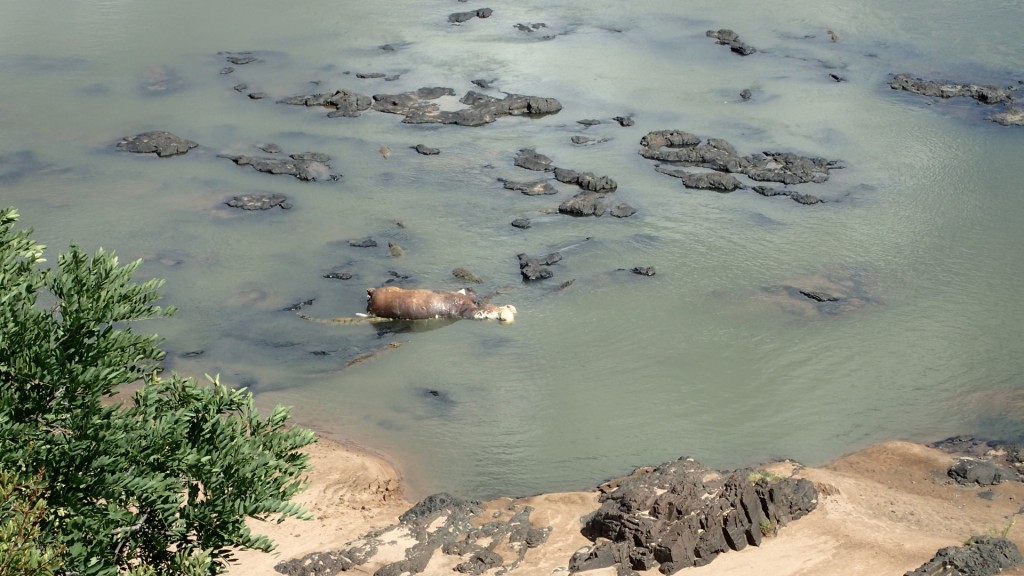


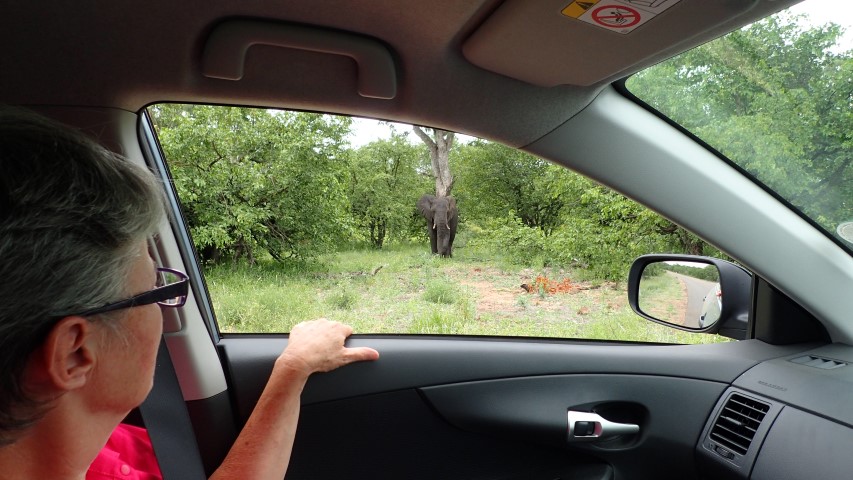
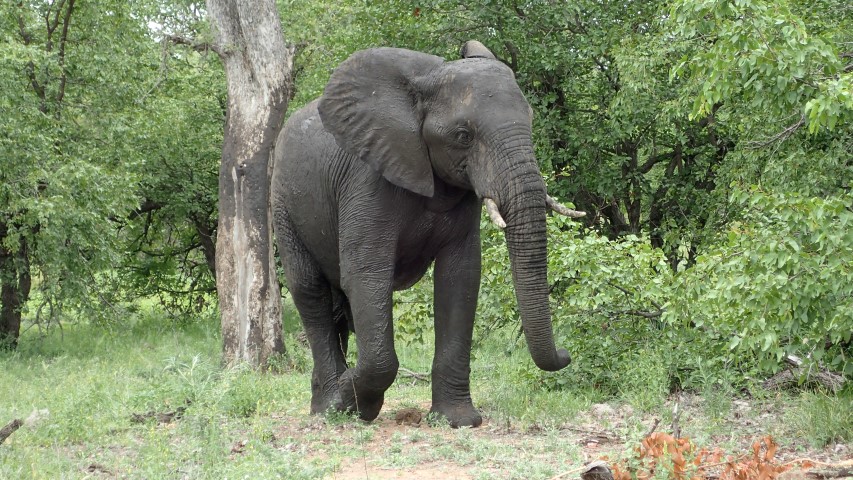
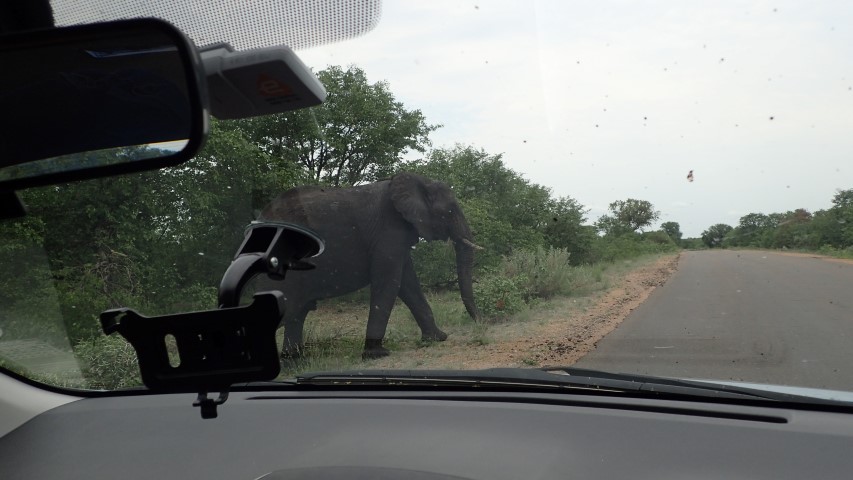
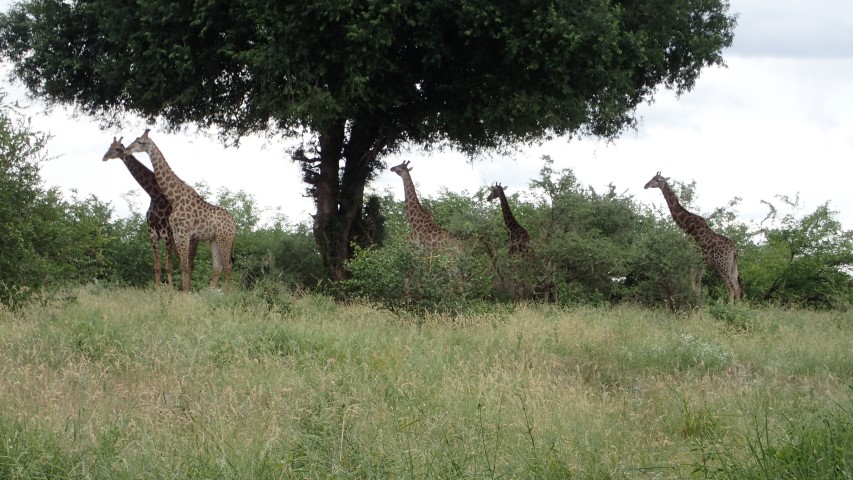
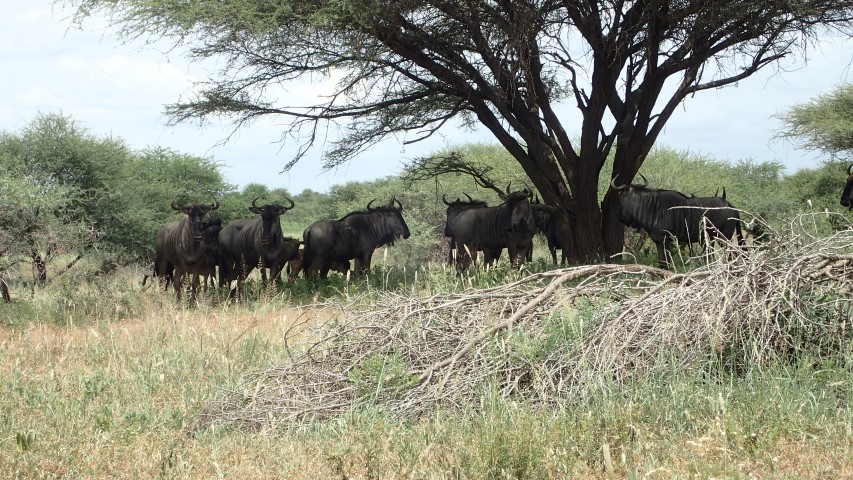
We’ve made it! If it hadn’t taken us so much longer than we intended, arriving at Kruger wouldn’t really be a big deal. As the country’s most popular and best-known tourist destination, people visit this park in droves – as day visitors, on bus tours, to stay overnight or longer, to see wildlife and to generally just chill out.
Still, our travels to get here have been interesting and thankfully we’ve had no major mishaps along the way. We somehow just seem to choose the ‘road less travelled’, don’t we?
We have been driving through orange groves, banana and mango plantations and past farms growing tomatoes, peppers, pumpkins and maize. Always maize, planted wherever there are a few spare metres of vacant land. On our way here, we drove past the area where the liqueur Amarula is made. It’s a creamy liqueur made from marula fruit, known as ‘elephant fruit’ because apparently elephants will walk for miles to eat them, they are so delicious. We saw people picking the fruit from trees by the side of the road. I guess if there is one commercial manufacturer of Amarula, there are lots of backyard operations and ‘home-brewers’ of it as well.
